
Wasps in the family Pompilidae are commonly called spider wasps, spider-hunting wasps, or pompilid wasps. The family is cosmopolitan, with some 5,000 species in six subfamilies. Nearly all species are solitary, and most capture and paralyze prey, though members of the subfamily Ceropalinae are kleptoparasites of other pompilids, or ectoparasitoids of living spiders.

Episyron is a genus of wasps in the family Pompilidae which prey on spiders. Nine species are found in Europe.

Episyron rufipes, the red-legged spider wasp, is a red and black or completely black spider-hunting wasp.

Episyron quinquenotatus, the white-trimmed black wasp, is a North American species of pompilid spider hunting wasp.

Pompilus cinereus, the leaden spider wasp is the most widespread species of the Pompilus spider wasps, and throughout a large proportion of its wide distribution is the only species of Pompilus. It is the type species of the genus Pompilus and therefore of the family Pompilidae.
Dipogon bifasciatus is a spider wasp from the family Pompilidae.
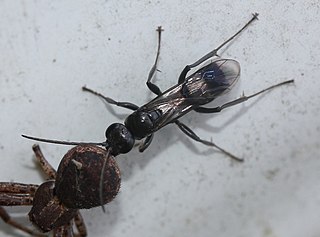
Dipogon is a genus of spider wasps of the family Pompilidae in the subfamily Pepsinae. They are found in Europe, Asia, and North America. Their generic name comes from the characteristic long bristle tufts just below the mandibles, which are used to carry material to construct the cells in the nest, and for constructing the nest.

Dipogon subintermedius is a spider wasp from the family Pompilidae.
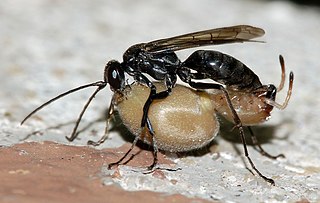
Auplopus carbonarius is a spider wasp of the family Pompilidae. Uniquely among the British group it constructs a nest of barrel-shaped cells in which spiders are stored and the larvae develop.
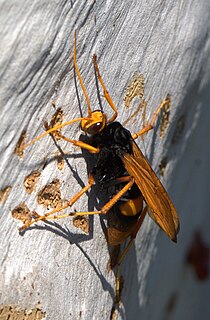
Cryptocheilus is a genus of spider wasps of the subfamily Pepsinae, they are found in the world's warmer regions. They vary in size from medium to large and are often strikingly coloured. The females construct multicellular nests in cavities, once built each cell is stocked with a spider, captured by the female. They are found in open habitats such as heaths, meadows and forest edges.
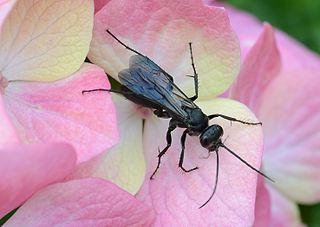
Anoplius nigerrimus is one of the most common spider wasps, or pompilids, in Europe. They are mostly black and the females are 6-8 mm long while males measure 5-8 mm. This species may be distinguished from the related Anoplius concinnus and Anoplius caviventris by the 20 setae, or hairs, on the forehead rather than 60 or 45.
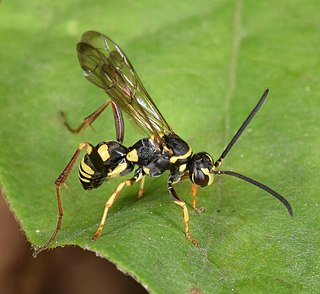
Ceropales maculata is a kleptoparasitic spider wasp found in the holoarctic region.

Ceropales is a genus of kleptoparasitic spider wasps from the sub-family Ceropalinae of the family Pompilidae. They are characterised by the taking of the spider prey of other solitary wasps, mainly Pompilidae but members of the Sphecidae that provision with spider prey are sometimes also hosts. In some languages their name translates into English as "cuckoo spider wasp".

Aporus unicolor, common name cutpurse, is a highly specialised spider hunting wasp from the family Pompilidae.

Evagetes is a genus of spider wasps from the family Pompilidae. There are 72 described species, of which 58 are found in the Palaearctic region, 11 in the Nearctic region, with a few penetrating to the Afrotropical, Oriental and Neotropic regions. Evagetes wasps are kleptoparasitic on other pompilid wasps, especially the genera Arachnospila, Anoplius, Episyron and Pompilus, digging into their sealed burrows, eating the host egg and replacing it with an egg of its own. Evagetes wasps are characterised by their very short antennae. Most are species are black with the base of the antennae rufous, several Evagetes species are very metallic bluish insects.
Evagetes crassicornis is a kleptoparasitic spider wasp with a holarctic distribution.
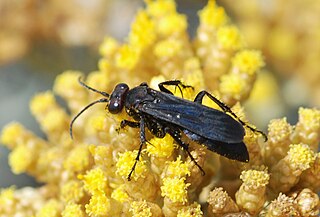
Agenioideus is a genus of spider wasps from the subfamily Pompilinae; the genus occurs in Europe, where 21 species are recorded, eastwards to Japan, in North America, South America, and Australia.
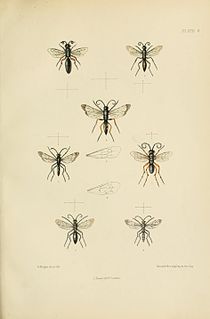
Agenioideus cinctellus is a spider wasp of the subfamily Pompilinae with a Palearctic distribution.

Caliadurgus is a genus of spider wasps of the subfamily Pepsinae. These are medium-sized black spider wasps with some red. They have a catholic habitat choice and their preferred prey are spiders of the families Araneidae and Tetragnathidae. They have a Holarctic and Neotropical distribution.
Priocnemis hyalinata is a large species of pepsine spider wasp.
















